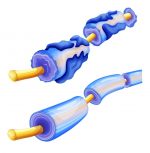Combined Genetic and Protein Analysis Reveals New Risk Genes
Findings may highlight new proteins to aid in diagnosing, treating the condition

Higher activity of the genes SHMT1, FAM120B, and ICA1L in the brain may increase the risk of developing multiple sclerosis (MS), a new study reports that for the first time linked two of the genes to risk for the disease.
The findings may help to better understand the biological underpinnings of MS and highlight new proteins that could aid in diagnosing and treating it.
The study, “Brain proteome-wide association study linking-genes in multiple sclerosis pathogenesis,” was published in the Annals of Clinical and Translational Neurology.
The exact causes of MS are not yet clear, but a number of genetic and environmental factors are believed to play a role. This leads to wide variability in how the disease develops and progresses, making the discovery and validation of biomarkers that help guide its diagnosis and prognosis in each patient essential.
To identify new biomarkers of risk, researchers from China planned a multistep assessment of genes that might be linked to abnormal protein levels in the brains of MS patients.
The researchers focused on a specific brain region linked to MS susceptibility in previous studies. Called the dorsolateral prefrontal cortex, it’s involved in executive functions such as planning and working memory.
Linking genetic, protein studies
The researchers used data from a genome-wide association study (GWAS) — including 14,802 MS patients and 26,703 healthy people — and data from two proteome-wide association studies (PWAS).
GWAS studies collect large amounts of genetic and clinical data to identify genetic changes that might be linked to a disease or a clinical feature. PWAS studies have a similar goal, but analyze changes in protein abundance instead of genetic variations.
This multilayered process was done to “identify genomic architecture-associated protein biomarkers for MS and to provide promising targets for future pathogenesis studies,” the researchers wrote.
In the study, the team integrated GWAS data with two different PWAS datasets, each including 376 and 152 people. The goal was to discover changes in DNA in the brain of MS patients that also resulted in changes in protein levels.
From a total of 51 genes identified in the combined datasets as having a significant link with MS risk, six were independently found in the two PWAS datasets and defined as candidate risk genes.
These candidates were then validated by measuring their activity in specific brain regions and comparing levels between patients and healthy controls. This is an important step because targets identified by GWAS and PWAS don’t always reflect measurable physiological changes in tissues.
Of the six genes, three — SHMT1, FAM120B, and ICA1L — showed significant changes in MS patients compared with controls. In particular, SHMT1 and FAM120B activity was increased in the white matter (brain region composed mainly of nerve fibers where the myelin sheath that’s damaged in MS resides). In turn, ICA1L was less active in the gray matter, which is made mainly of cell bodies.
“These risk genes affected protein abundance via the process of [gene expression] and confer MS risk,” the researchers wrote.
Looking at specific brain regions, the team found SHMT1 activity was increased in both active and inactive MS lesions in white matter, but not in normal-appearing white matter tissue. In contrast, FAM120B was increased in both lesions and normal-appearing white matter tissue, while ICA1L was decreased in both lesions and normal gray matter tissue.
While SHMT1 has been previously linked to MS, this is the first study to identify FAM120B and ICA1L as new risk genes for MS. “Our findings shed new light on the pathogenesis of MS and prioritized promising targets for future therapy research,” the researchers wrote.
The GWAS and PWAS datasets used in this study were from primarily European populations, which might limit the findings. Another limitation is the smaller sample size of the PWAS data sets. Studies with larger and more ethnically diverse populations are needed.
“These findings implicated causal biological pathways involved in the pathogenesis of MS, which illuminates the direction for further exploration in the future. More studies are warranted to discover the underlying mechanism of abnormal changes in these proteins and their related pathways in MS,” the researchers said.







